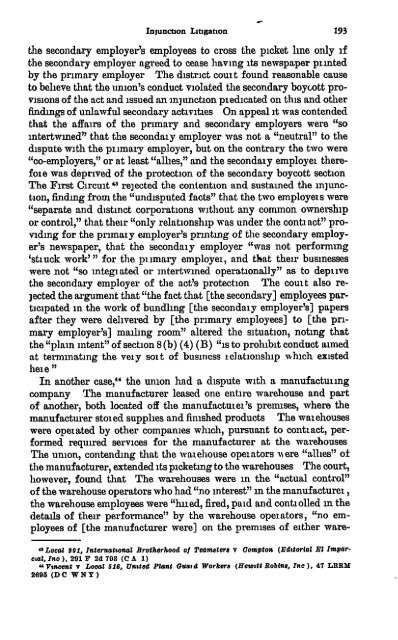TWENTY-SIXTH ANNUAL REPORT - National Labor Relations Board
TWENTY-SIXTH ANNUAL REPORT - National Labor Relations Board
TWENTY-SIXTH ANNUAL REPORT - National Labor Relations Board
Create successful ePaper yourself
Turn your PDF publications into a flip-book with our unique Google optimized e-Paper software.
Injunction Litigation 193<br />
the secondary employer's employees to cross the picket line only if<br />
the secondary employer agreed to cease having its newspaper printed<br />
by the primary employer The district court found reasonable cause<br />
to believe that the union's conduct violated the secondary boycott provisions<br />
of the act and issued an injunction predicated on this and other<br />
findings of unlawful secondary activities On appeal it was contended<br />
that the affairs of the primary and secondary employers were "so<br />
mtertwmed” that the secondary employer was not a "neutral" to the<br />
dispute with the primary employer, but on the contrary the two were<br />
"co-employers," or at least "allies," and the secondary employer therefore<br />
was deprived of the protection of the secondary boycott section<br />
The First Circuit 43 rejected the contention and sustained the injunction,<br />
finding from the "undisputed facts" that the two employers were<br />
"separate and distinct corporations without any common ownership<br />
or control," that their "only relationship was under the contract" providing<br />
for the primary employer's printing of the secondary employer's<br />
newspaper, that the secondary employer "was not performing<br />
'struck work'" for the primary employer, and tltat their businesses<br />
were not "so integrated or intertwined operationally" as to deprive<br />
the secondary employer of the act's protection The court also rejected<br />
the argument that "the fact that [the secondary] employees participated<br />
in the work of bundling [the secondary employer's] papers<br />
after they were delivered by [the primary employees] to [the primary<br />
employer's] mailing room" altered the situation, noting that<br />
the "plain intent" of section 8(b) (4) (B) "is to prohibit conduct aimed<br />
at terminating the very sort of business relationship mhich existed<br />
here"<br />
In another case," the union had a dispute with a manufacturing<br />
company The manufacturer leased one entire warehouse and part<br />
of another, both located off the manufacturer's premises, where the<br />
manufacturer stored supplies and finished products The warehouses<br />
were operated by other companies which, pursuant to contract, performed<br />
required services for the manufacturer at the warehouses<br />
The union, contending that the warehouse operators mare "allies" of<br />
the manufacturer, extended its picketing to the warehouses The court,<br />
however, found that The warehouses were in the "actual control"<br />
of the warehouse operators who had "no interest" in the manufacturer,<br />
the warehouse employees were "lured, fired, paid and controlled in the<br />
details of their performance" by the warehouse operators, "no employees<br />
of [the manufacturer were] on the premises of either ware-<br />
4' Local 901, International Brotherhood of Teamstere v Compton (Editorial El rinparcial,<br />
/o), 291 F 2d 793 (C A 1)<br />
44 Vincent v Local 516, United Plant Goat d Workere (Hewitt Robins, Inc ), 47 LRRM<br />
2695 (DC WNY)

















